How to make homemade sauerkraut in at home. It is so easy to make fermented sauerkraut.
All you need is a head of fresh cabbage, salt and about 4 weeks of time to turn a head of cabbage into delicious homemade sauerkraut.
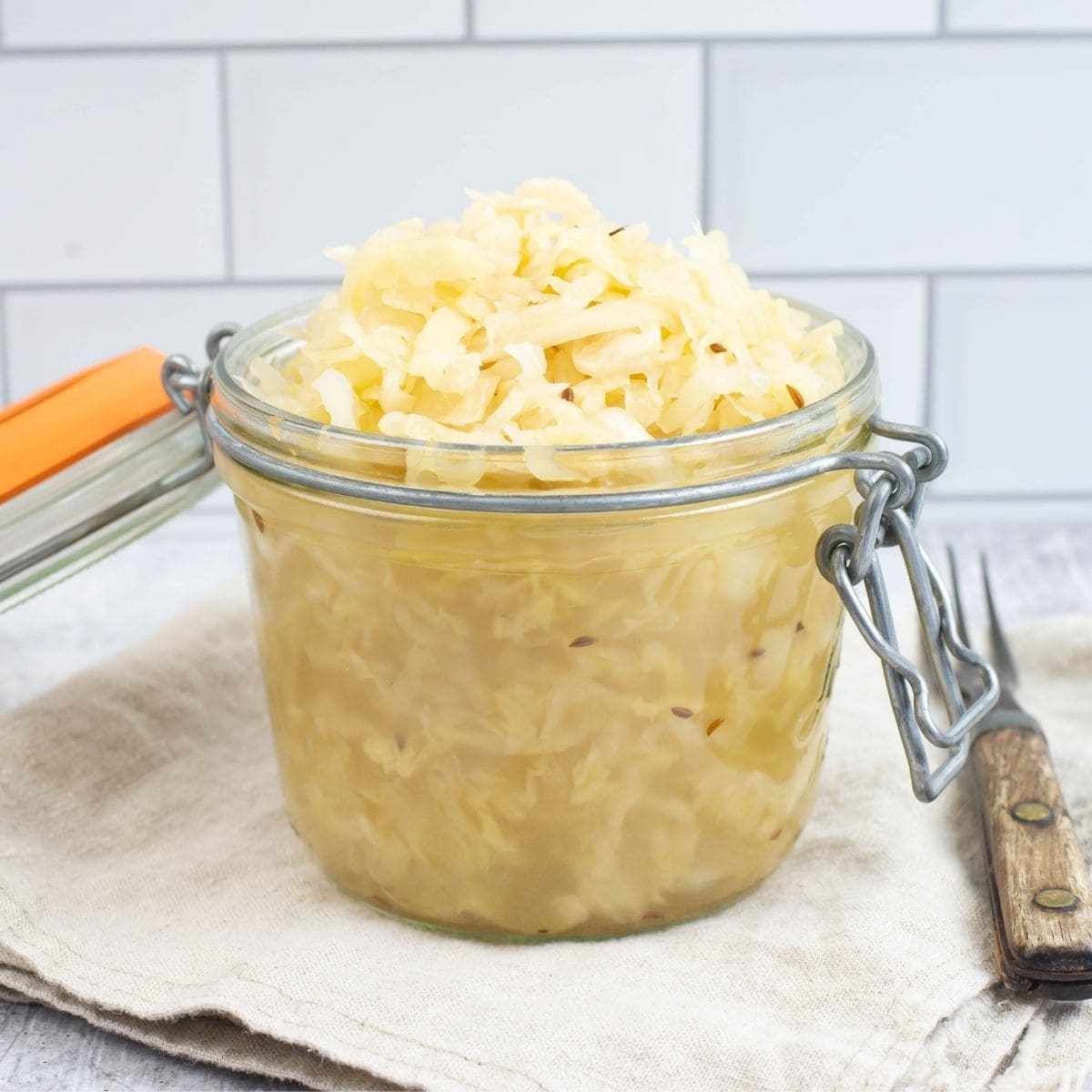
You'll also need a clean jar or two to ferment the cabbage in.
You can use wide mouth mason jars, a crock, a recycled glass jar or plastic food grade containers. Any of these containers will do the trick.
Homemade Sauerkraut
Making homemade sauerkraut is an easy and inexpensive way to start making and eating fermented vegetables.
If you love the crunchy tart flavors of fermented foods sauerkraut is one of the easiest recipes to start with.
An added bonus is the benefits of adding healthy probiotics from fermented foods to your diet.
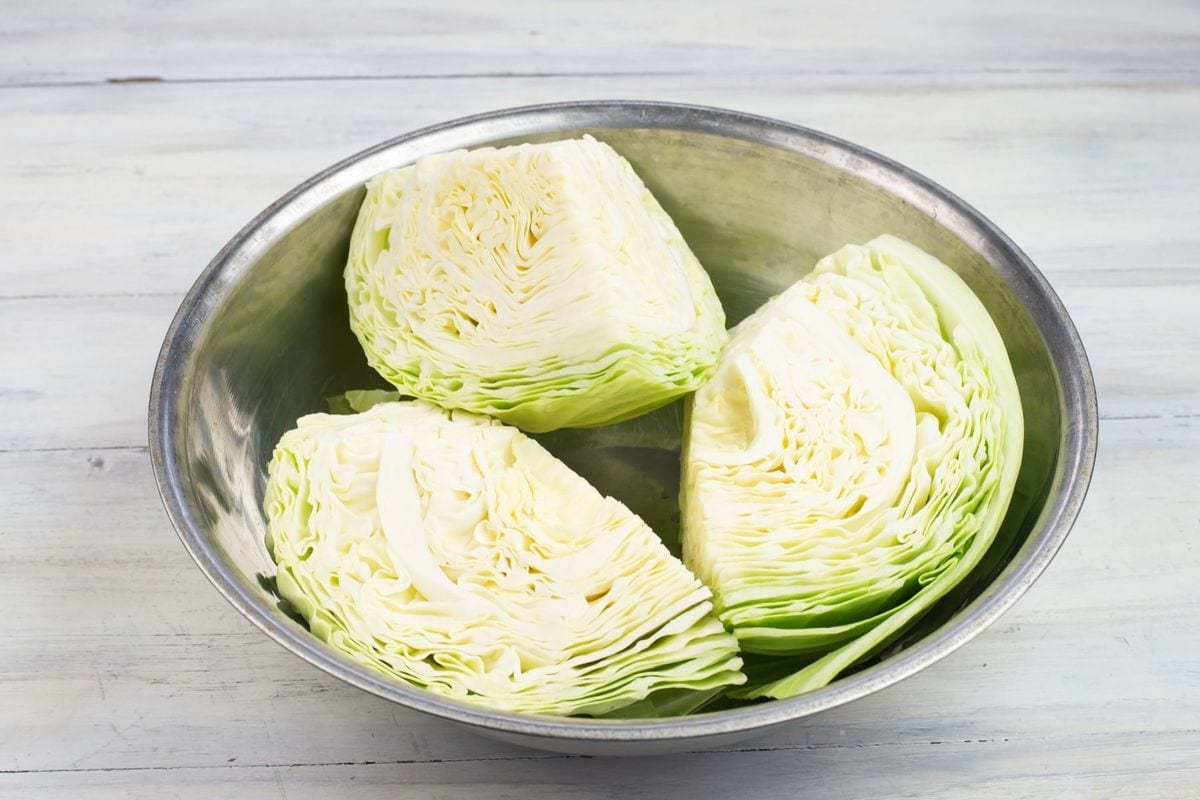
If you are a gardener and you have planted cabbage this year making sauerkraut is a great way to preserve some of the cabbage you have grown.
You can make sauerkraut from fresh green or purple cabbage.
Fermenting Equipment
- wide mouth mason jars, recycled jars or a fermentation crock
- wide mouth screw on canning lid bands
- fermenting weights (optional)
- pickle packer vegetable tamper (optional)
- silicone fermentation air locks (optional)
- lint free flour sack towels
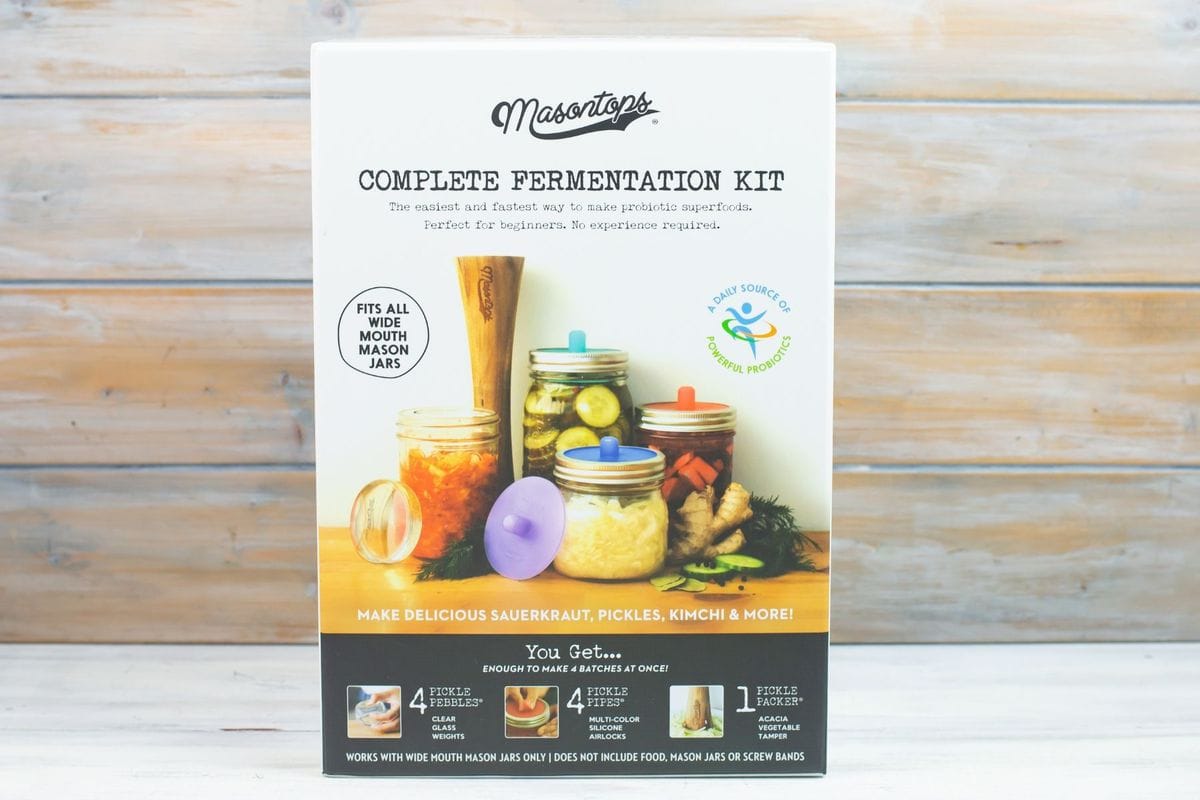
I am using the Masontops Complete Mason Jar Fermentation Kit. The kit comes with all the tools you need to ferment four jars of vegetables. This fermenting kit is not required to start fermenting.
After you have tried fermenting a couple of times and have decided that you love making and eating fermented vegetables you might consider buying the kit.
I experimented with making a few batches of Kimchi last summer and enjoyed it so much I bought this fermenting kit because it had everything I needed.
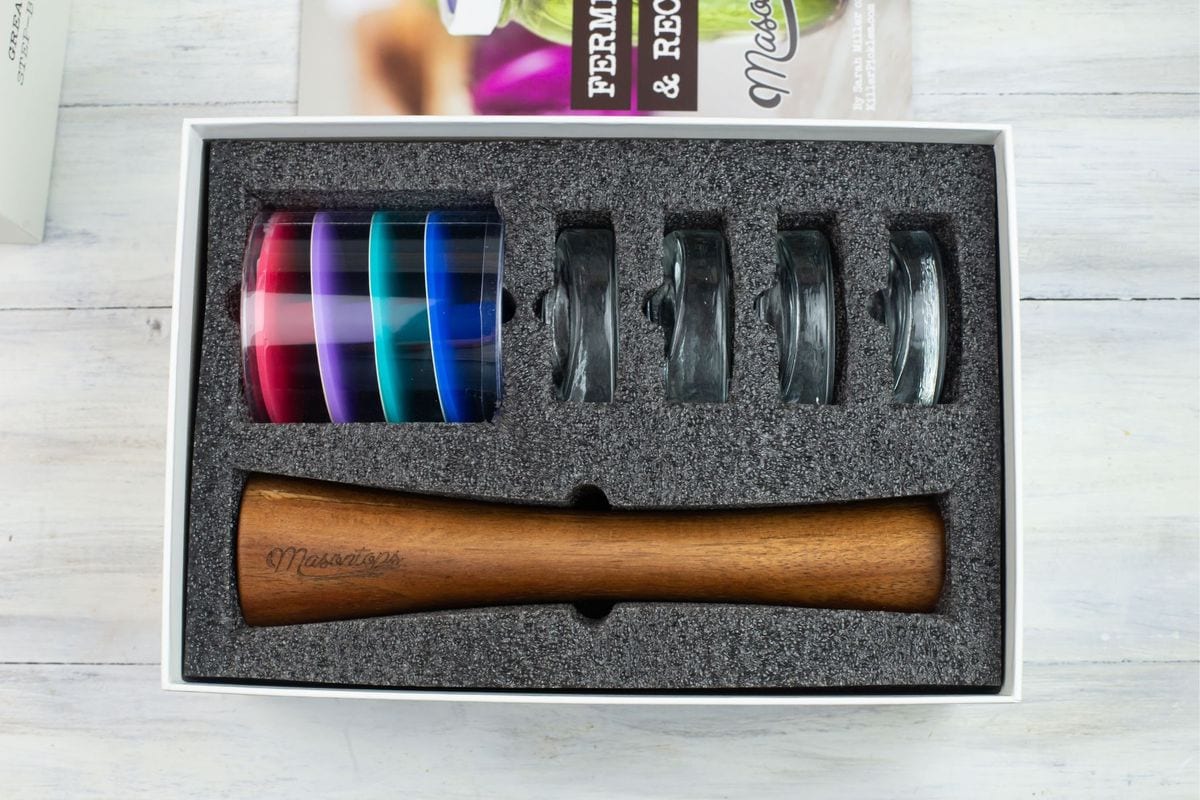
The fermenting kit does not come with mason jars. You will need to buy at least 4 wide mouth quart or half quart mason jars with 4 screw on ring bands.
Homemade Sauerkraut Ingredients
Homemade sauerkraut is very easy to make and only requires two ingredients.
You'll need a head of fresh cabbage and fine pickling salt to start fermenting cabbage at home.
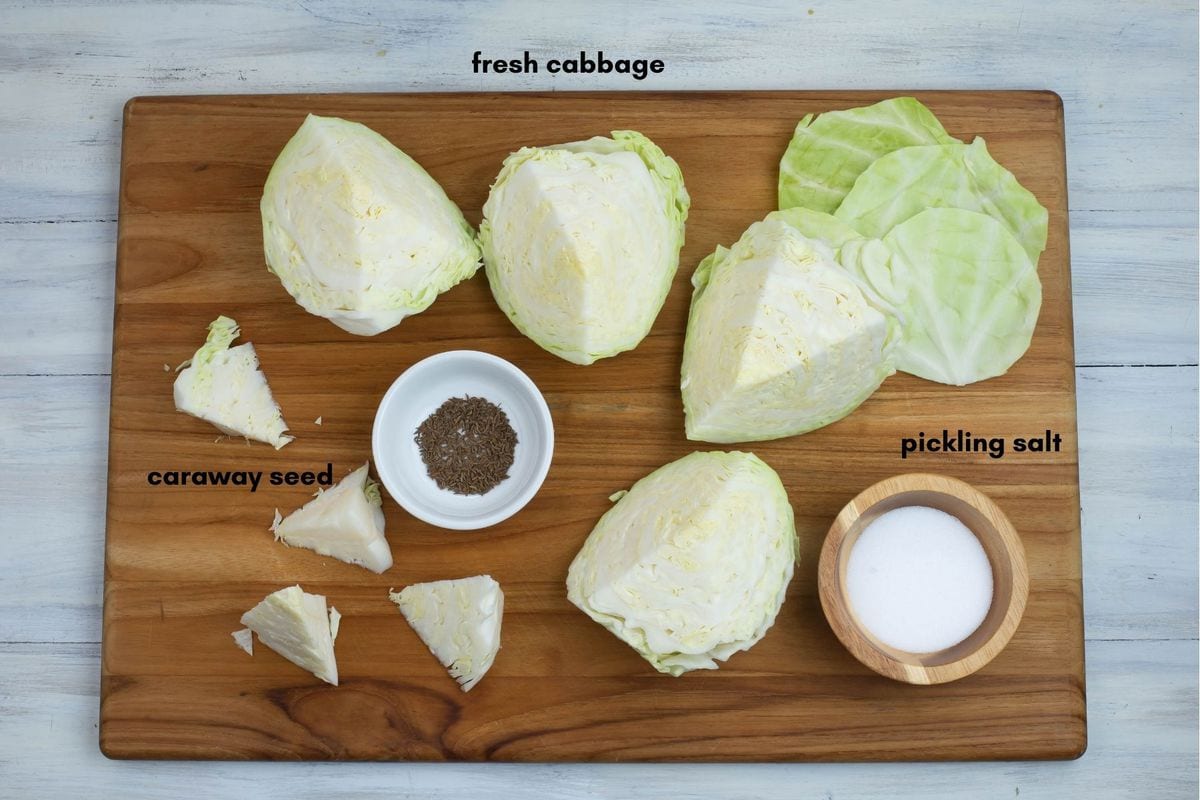
- a 5 lb. head of green or red/purple cabbage
- pickling salt: 1 tablespoon per 2 lbs. of shredded cabbage
- 1 teaspoons of caraway seeds (optional, but needed if you want to make German style sauerkraut)
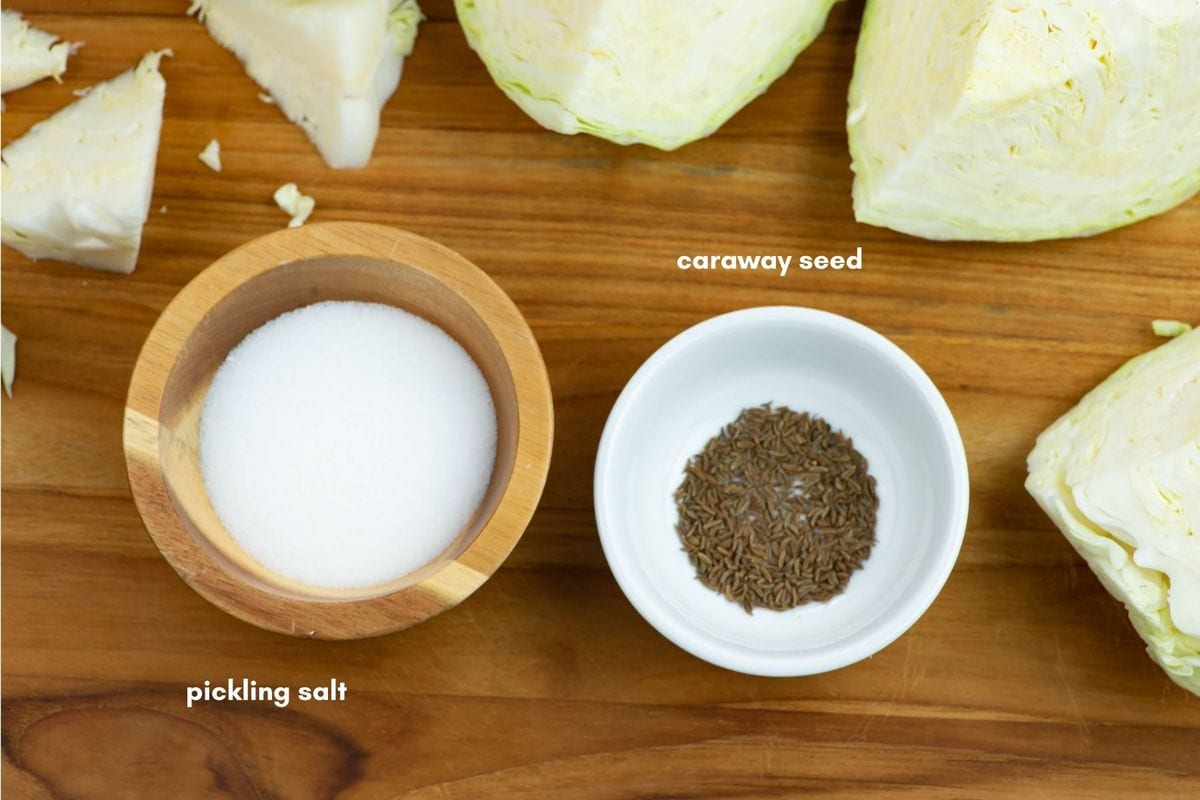
What type of salt
Using the correct type of salt is very important. You need to use a pickling salt when fermenting, making homemade pickles or canning. Table salt should not be used because it is not a pure salt because of the additives.
How to make homemade sauerkraut
Step 1: Wash and gently scrub the outside of a head of cabbage. Remove any blemished outer leaves.
Trim off two to three large outer leaves and set aside. These leaves will be used in place of fermenting weights.
You will place the leaves over the top of the cabbage after you have filled your jars if you do not have any weights.
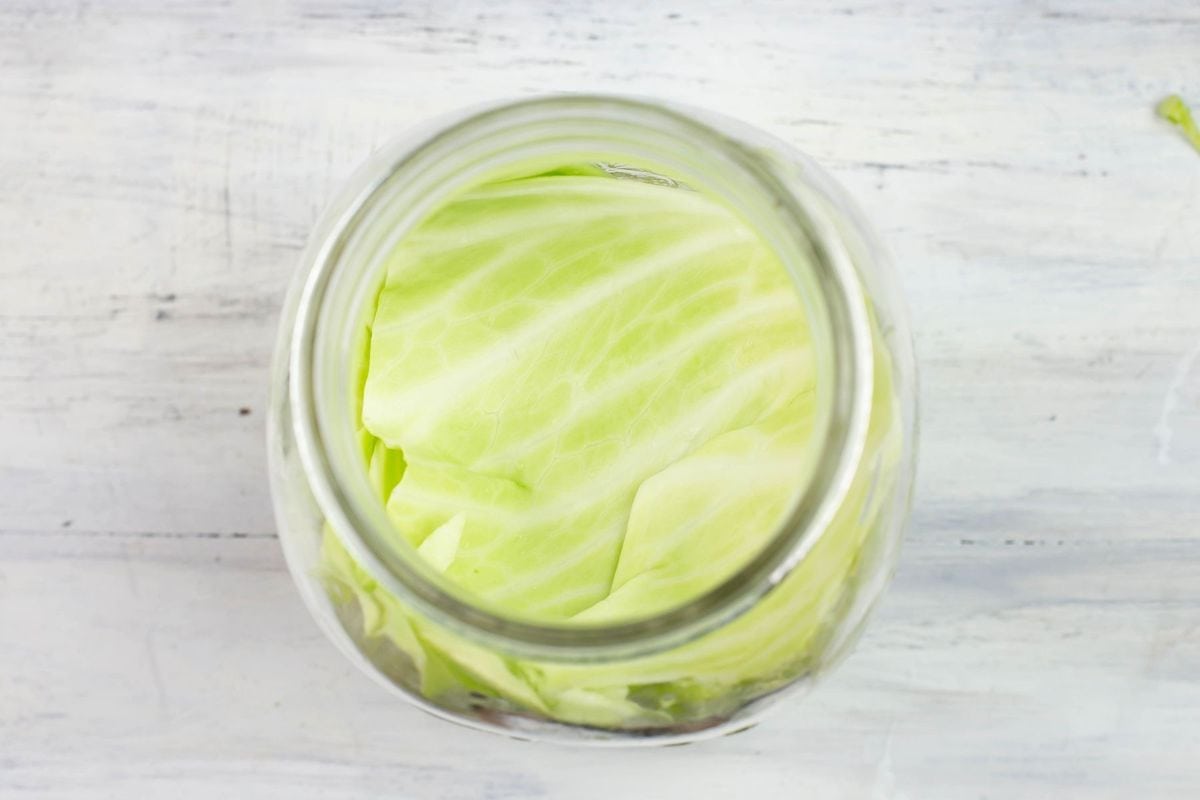
The leaves will help hold the cabbage under the brine instead of weights.
Weights work much better but the leaves can be used until you buy some weights.
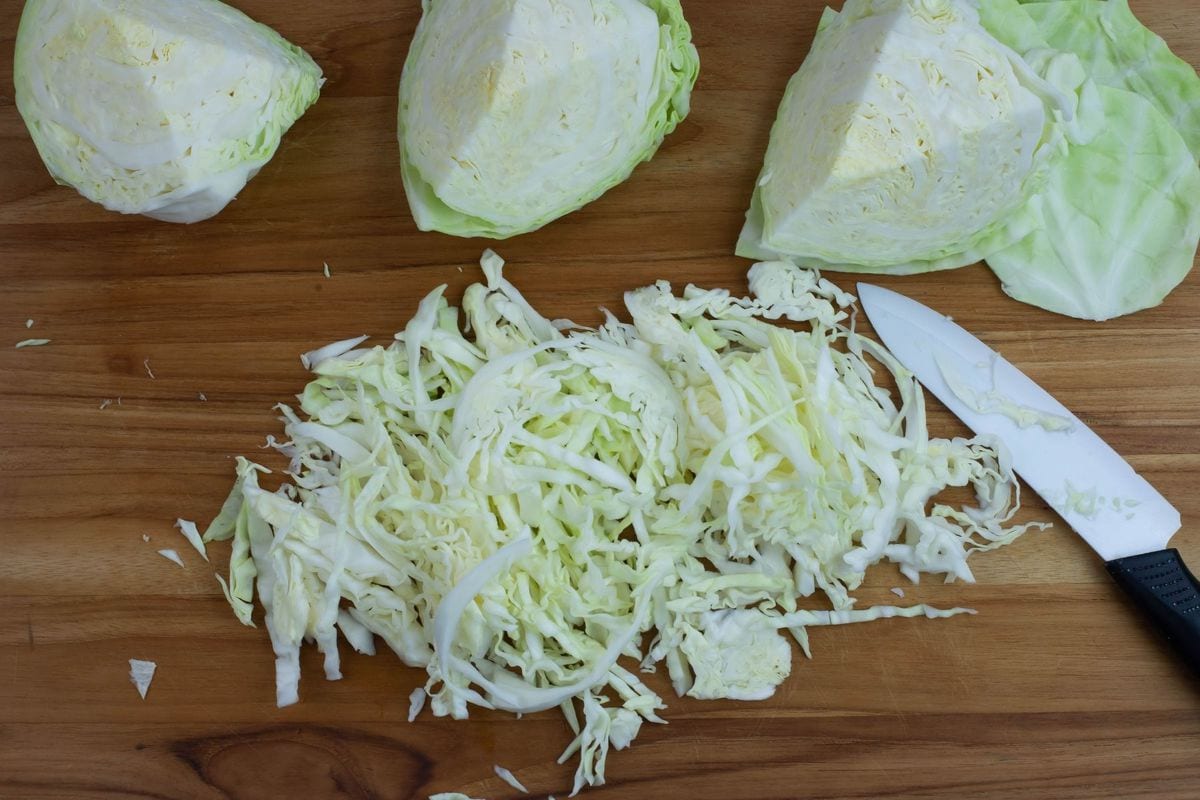
Step 2: Cut the head of cabbage in quarters. Trim off the core from each quarter piece. Using a very sharp knife cut the cabbage into very thin shredded ribbons.
Step 3: Transfer the shredded cabbage to a large bowl. Add the pickling salt and caraway seed if you are using it.
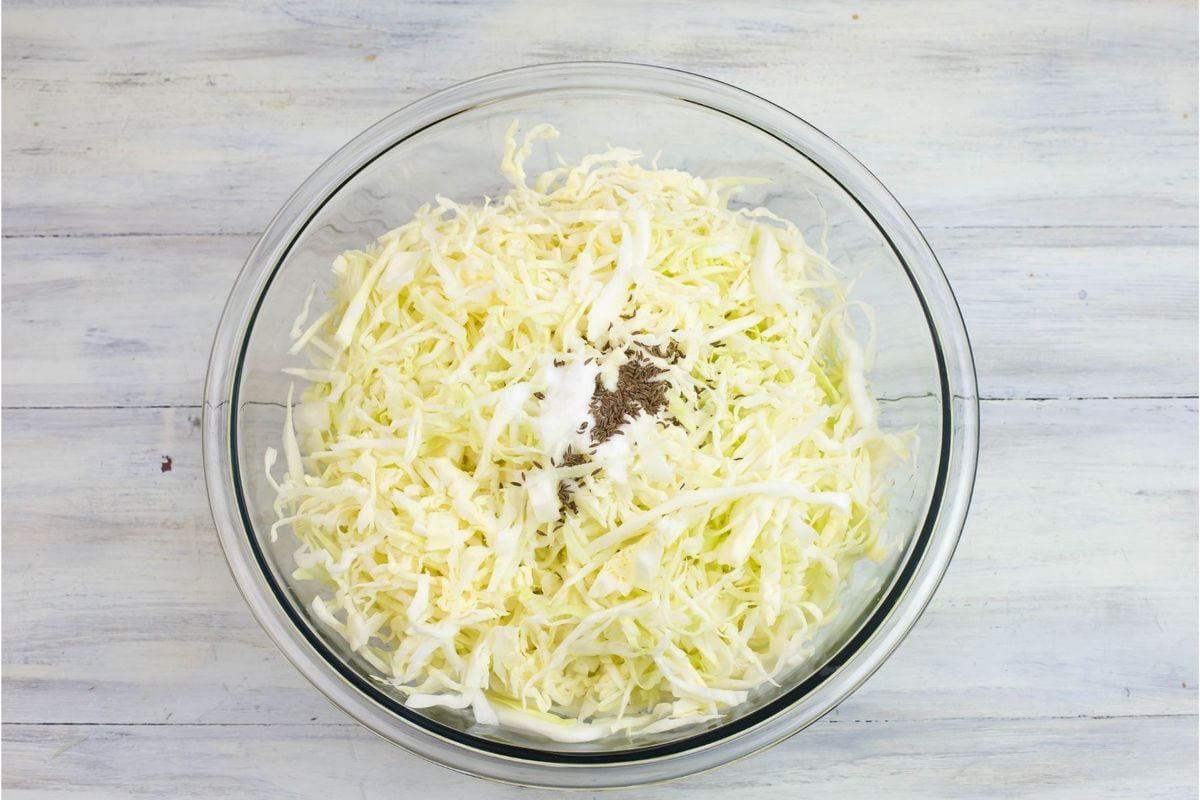
Step 4: Using clean hands toss the cabbage with the salt. As you toss to cover the cabbage with salt squeeze the cabbage to massage the salt in. Do this for about 3 minutes until the salt is evenly distributed.
Step 5: If you have a wooden vegetable tamper pound the cabbage until the cabbage is compressed, squeezing out more liquid.
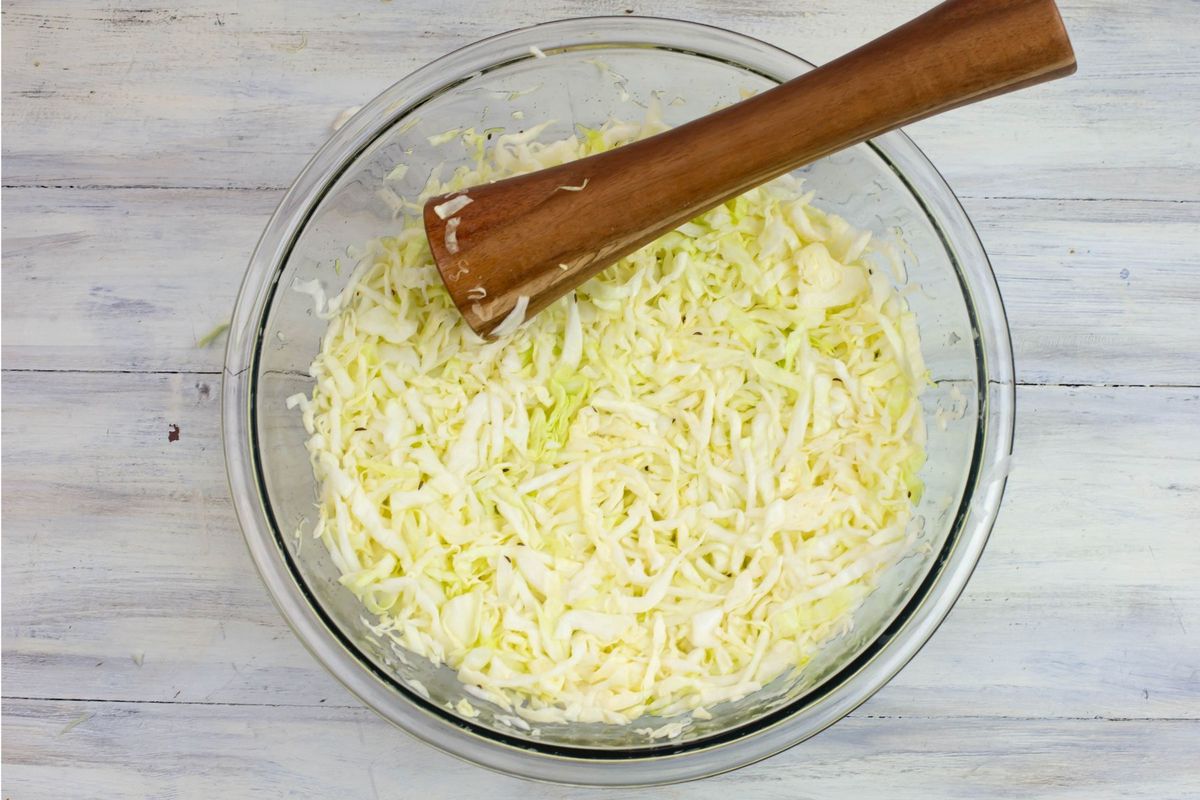
If you don't have a vegetable tampering tool you can place a heavy saucer on top of the cabbage and weight it down so it will compress the cabbage and help it release moisture for the brine.
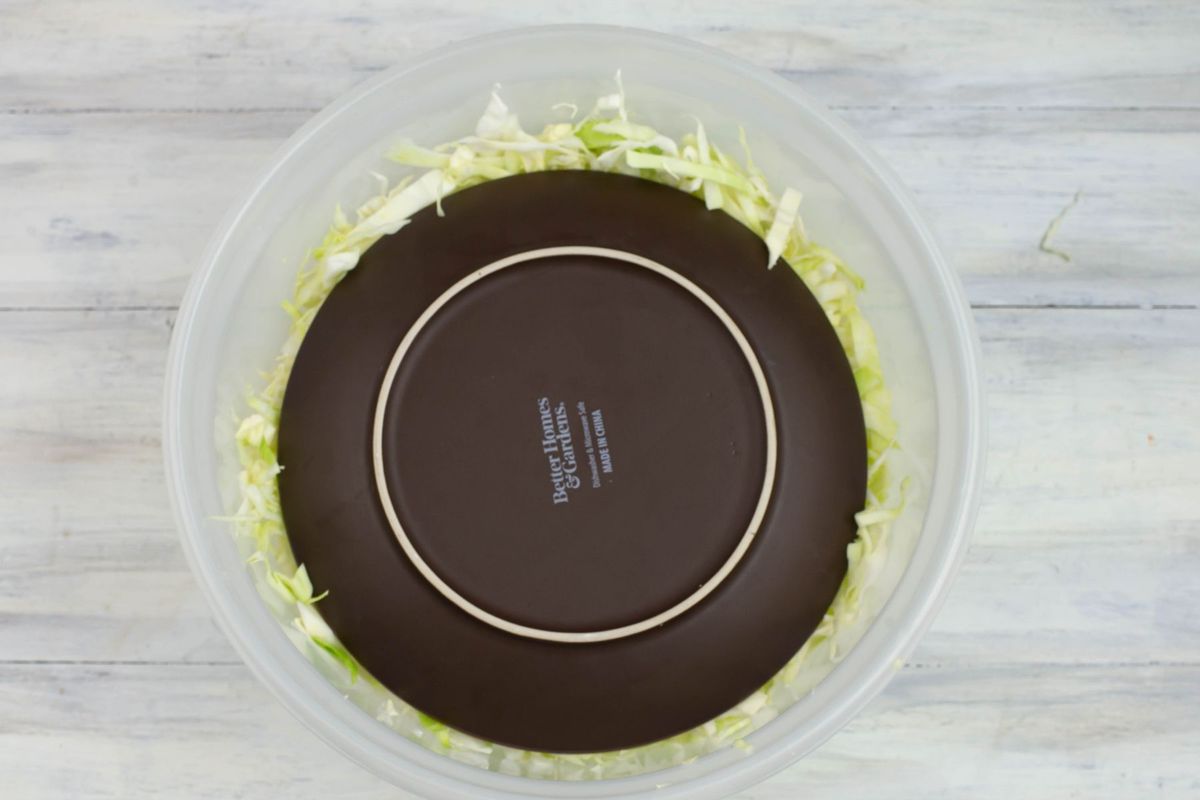
Step 6: Place a lint free towel over the top of the bowl and allow the cabbage to release moisture to create the brine. This process can take a couple of hours up to 48 hours.
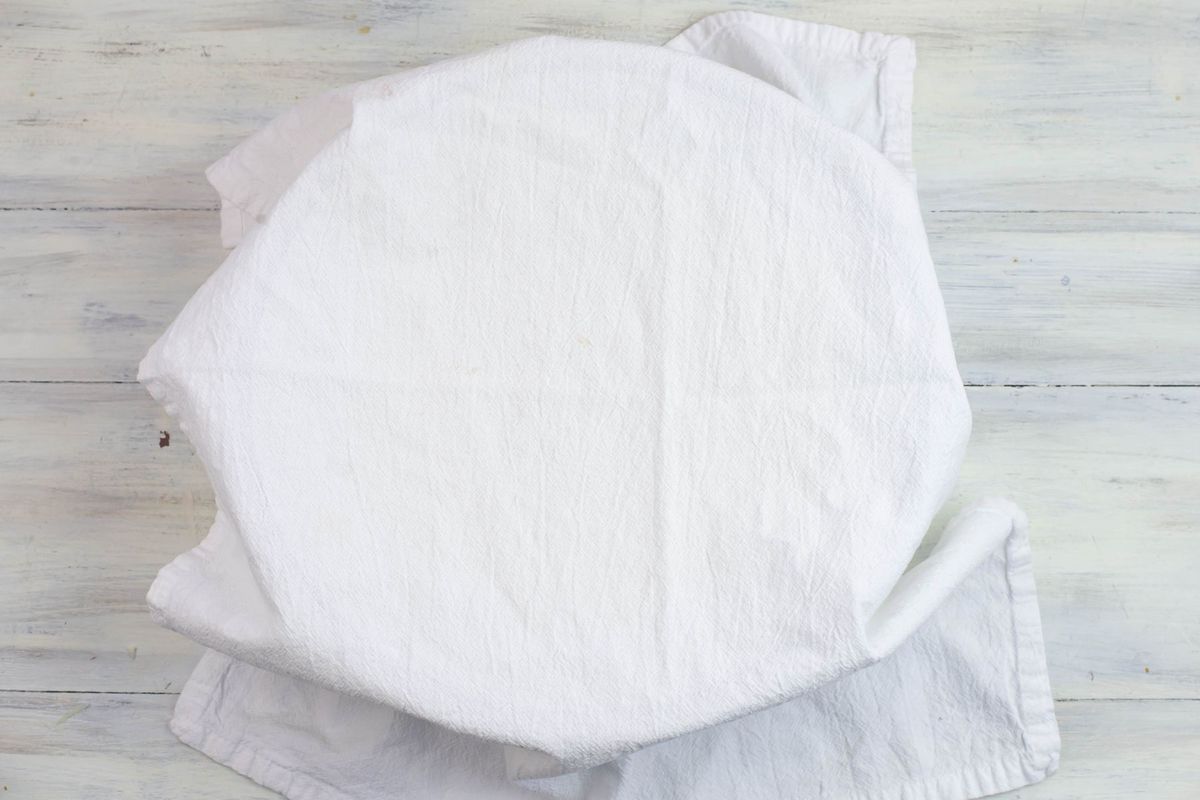
After just a couple of hours you can see that the cabbage and salt are starting to make a brine.
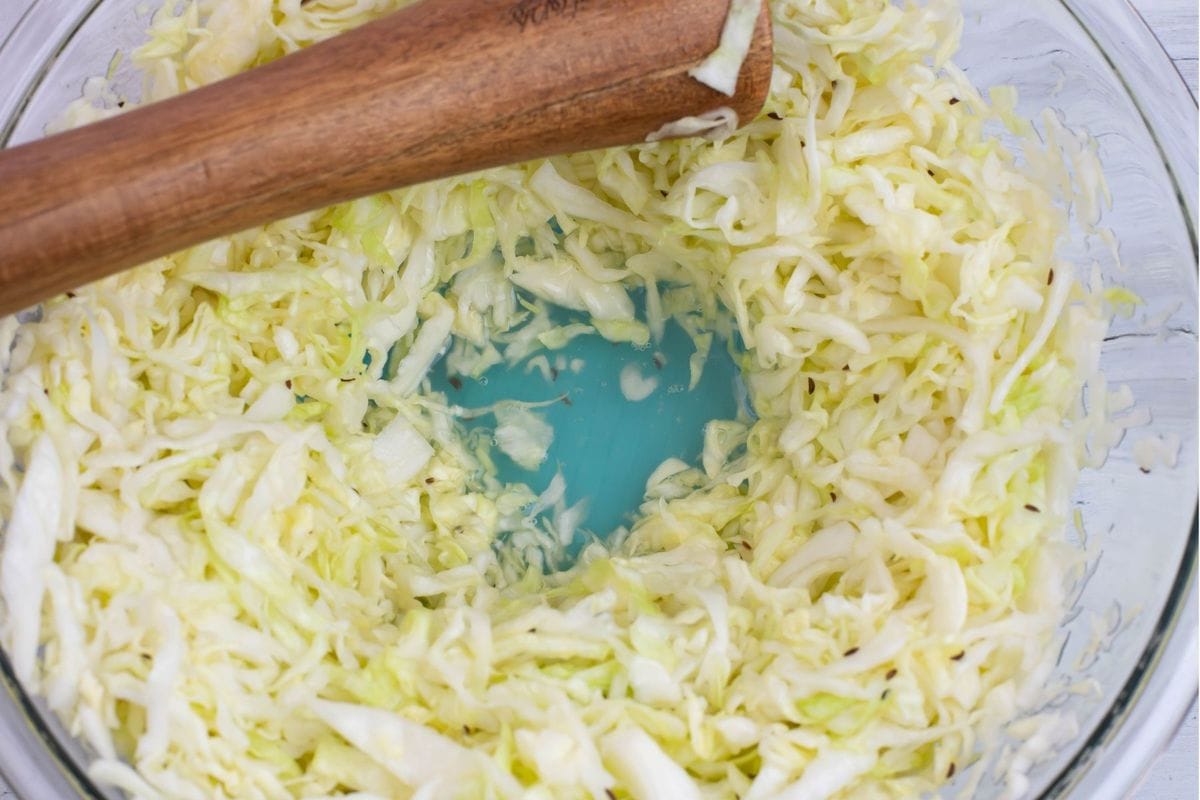
Step 7: Transfer the cabbage and all of the liquid to one or more wide mouth canning jars.
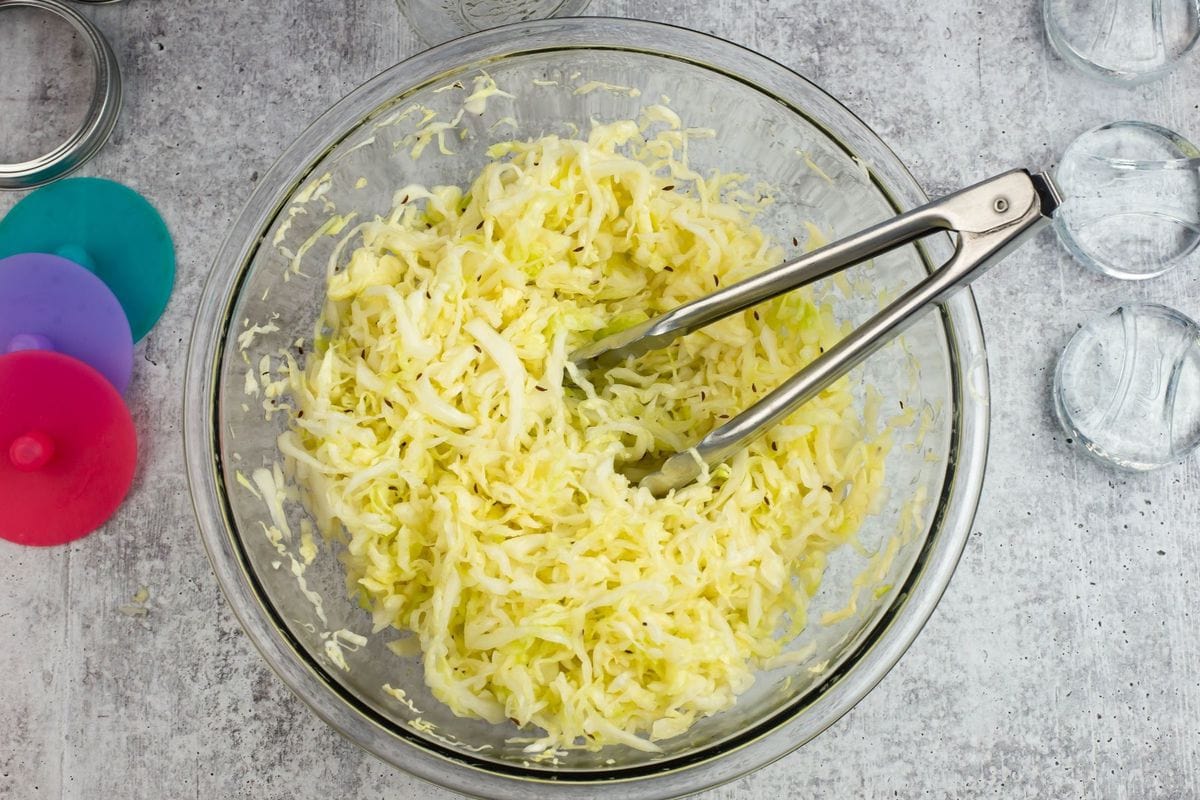
Use a wooden sauerkraut pounder to compress the cabbage in the jar. Only fill the jar to the shoulder of the jar to leave space for the weight.
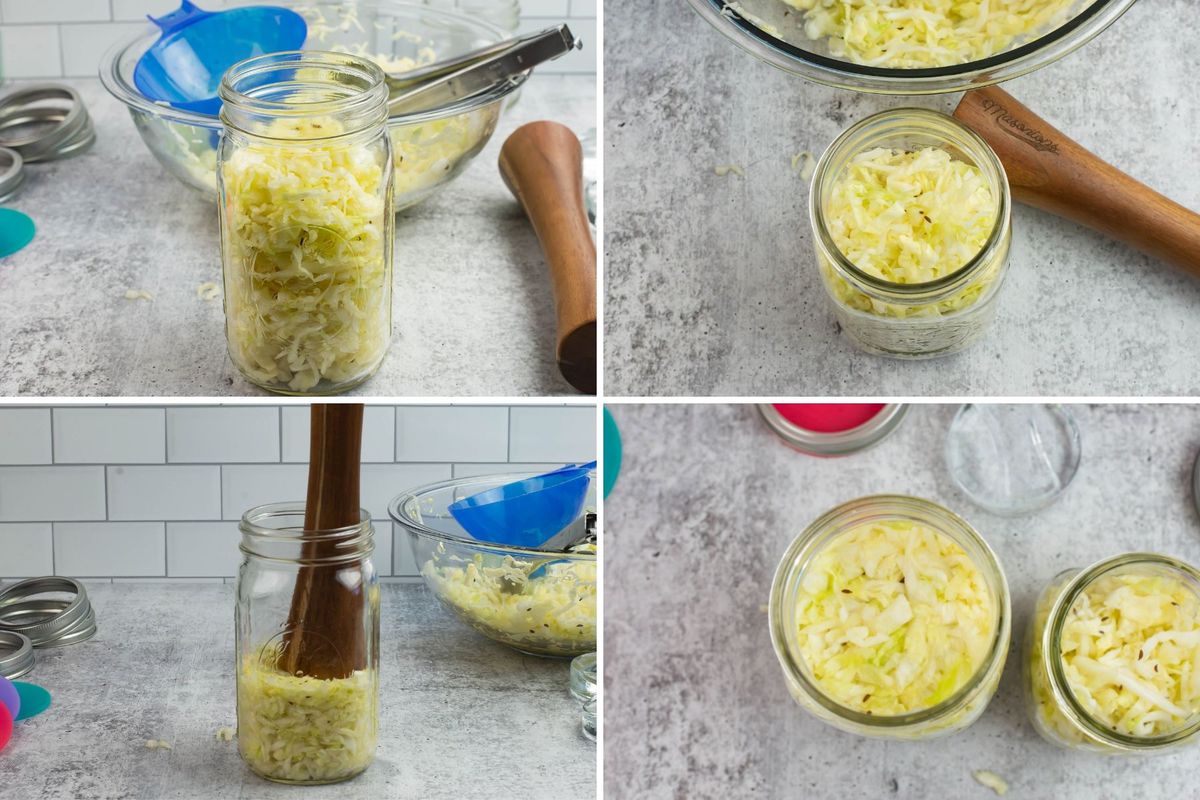
Brush any tiny pieces of cabbage off the inside neck of the jar. All of the cabbage should be submerged under the brine.
Place the weight into the jar if you have one. If you don't you will need to use the whole pieces of cabbage leaves you saved when you trimmed the cabbage earlier.
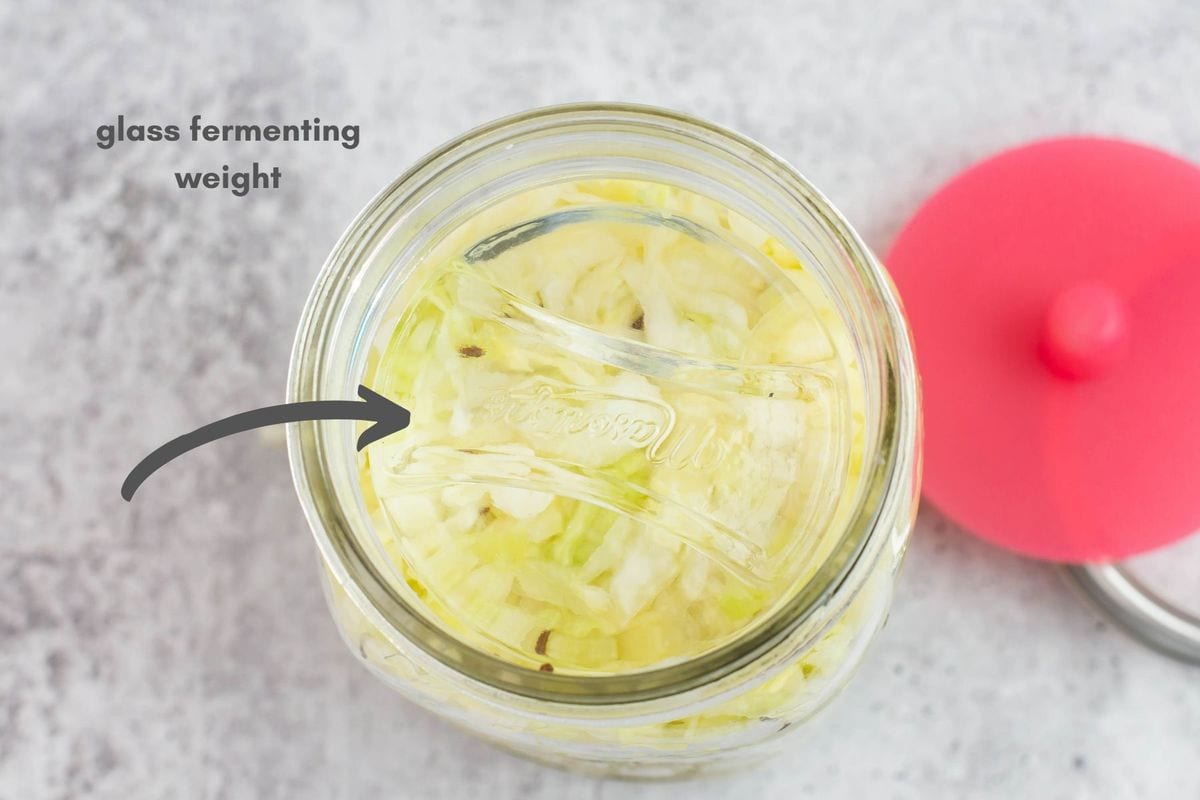
Trim the leaves so they fit into the mouth of the jar. Tuck the edges down under the brine around the inside edge of the jar. Push down on the leave so it comes into contact with the sauerkraut.
Step 8: Place a silicone fermentation airlock lid on top of the jar.
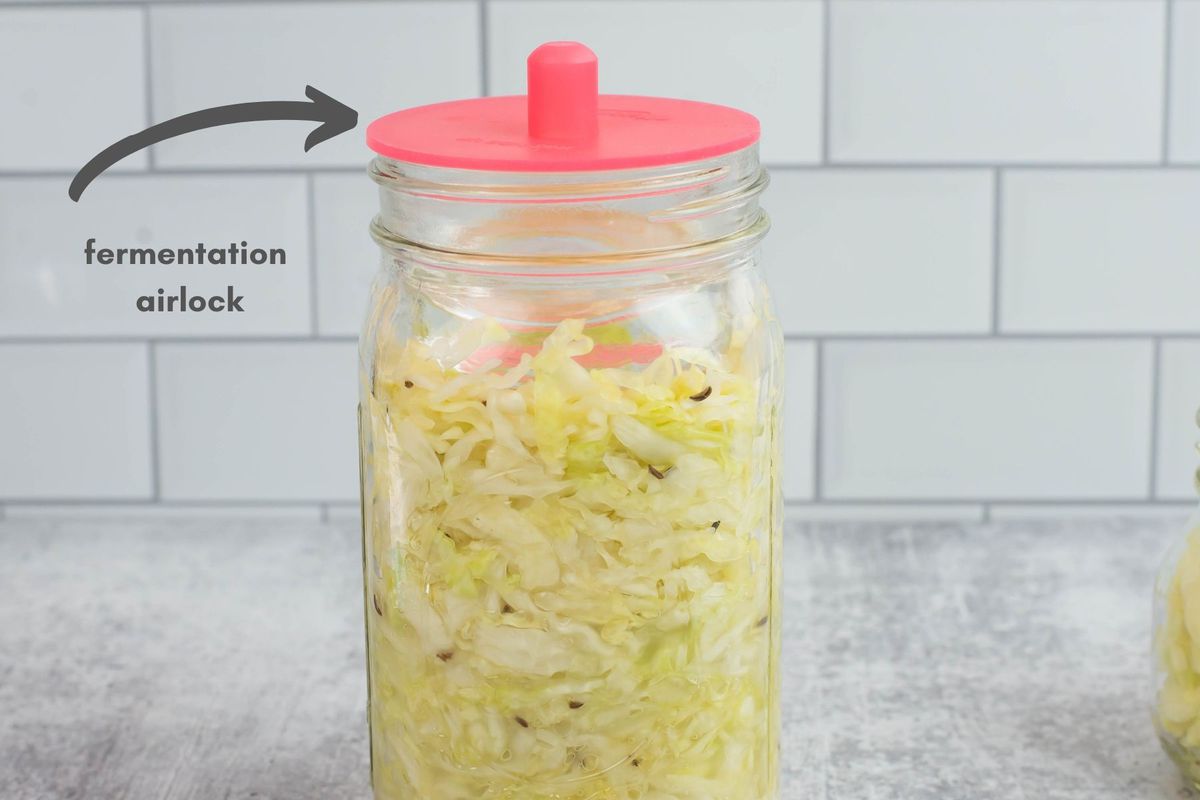
Step 9: Screw a canning lid band over the the airlock lid. Place the jar out of direct sunlight on the kitchen counter.

Step 10: Place the jar in a safe spot on the kitchen counter that is not in direct sunlight. Allow the sauerkraut to ferment for about 1 month. The airlock system will allow gasses to escape naturally as the cabbage ferments.
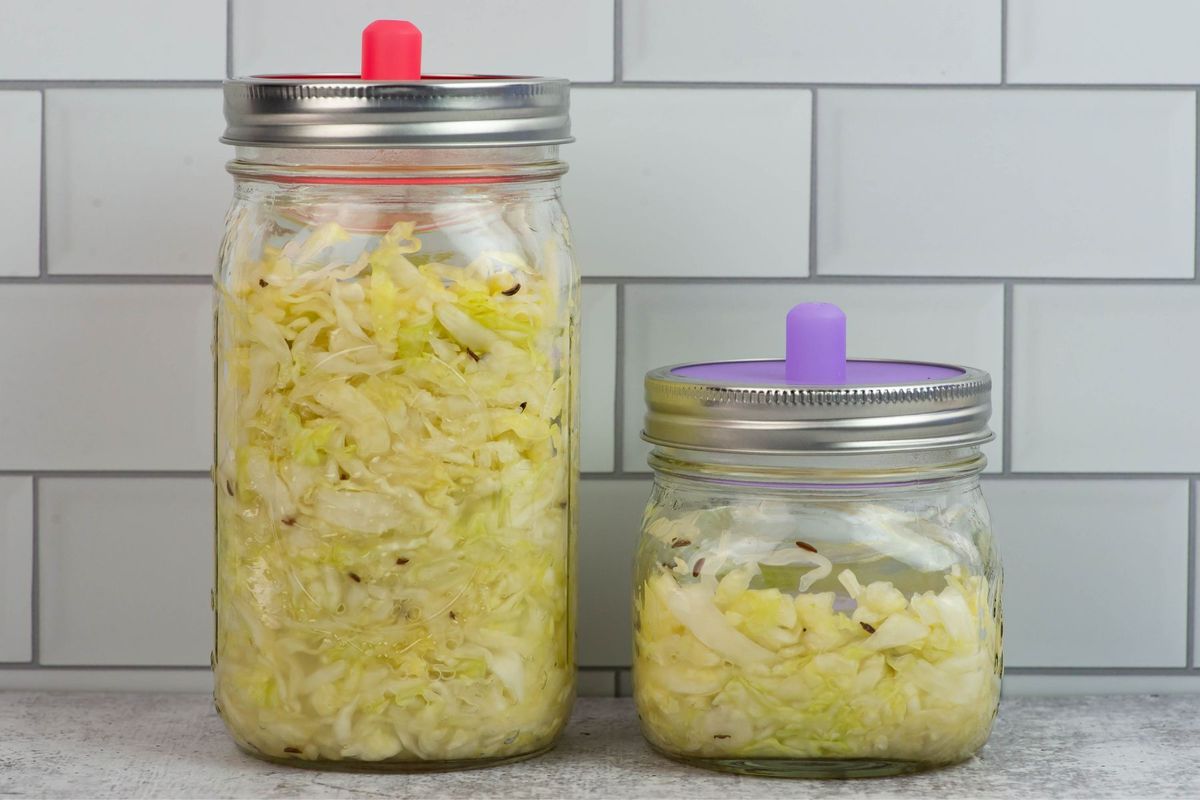
You can manually release the gasses by squeezing the nob on the silicone top.
What does fermenting cabbage look like?
You can tell that the fermentation process has started when you see the brine has started changing color and active bubbles have started floating to the top of the brine.
Keep in mind that the temperature in your home will play a big part in when the fermentation process.
The temperature inside my home is about 74 to 75 degrees. Because of the warmer temps fermentation begins quickly for me.
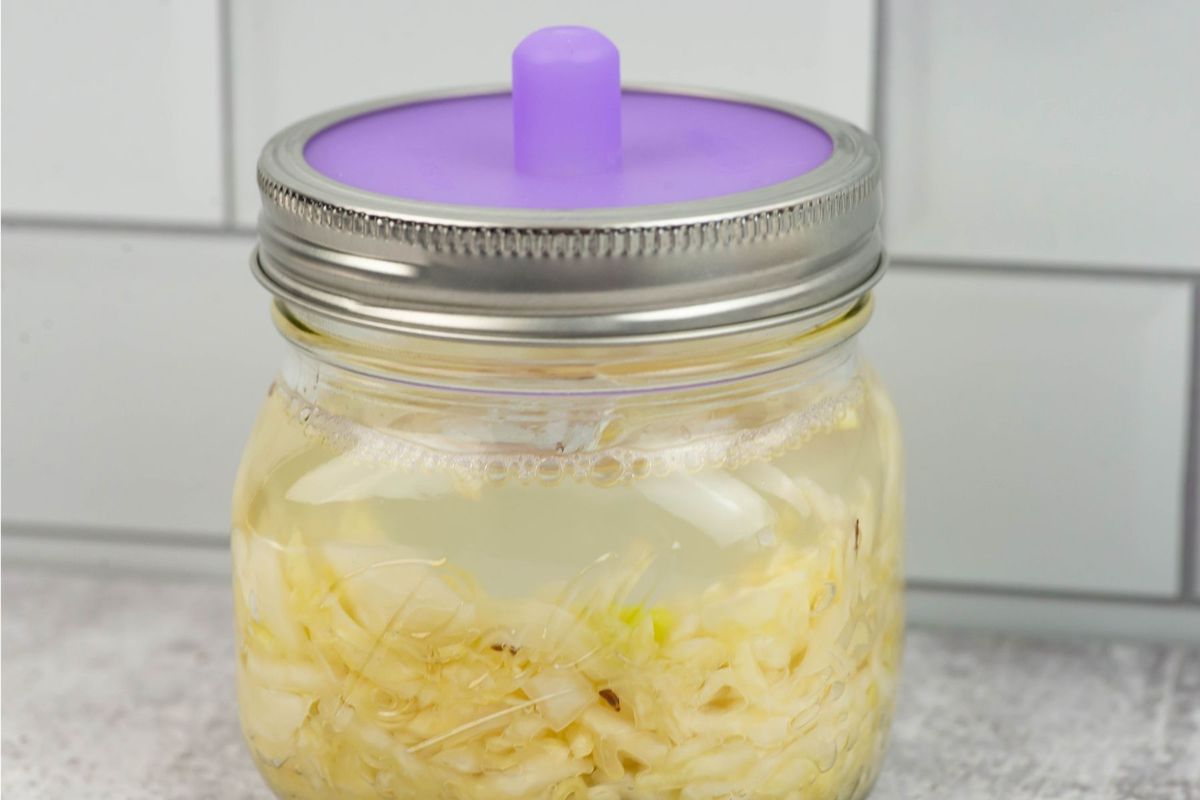
When to check homemade sauerkraut
Closely check each jar weekly.
- Brine level: Check to make sure the brine is covering the cabbage completely. The shredded cabbage needs to be completely submerged in the brine. See the Expert Tips below.
- Mold on ferments: Check to make sure there is no mold forming on the top layer of cabbage. Mold will be blackish in color. Any light colored floaters are fine. Scoop them out and discard. But if you see anything that looks like mold you will need to dump the batch and start over.
- Fermented cabbage color: Check the color of the cabbage. The cabbage should not turn a dark brown or black color. The cabbage will start to change to a pale color from the fermenting process. This is normal but if the brine level is too low the top layer of cabbage may start to darken and turn brown. If you catch it early enough you can top off the days with a light brine solution.
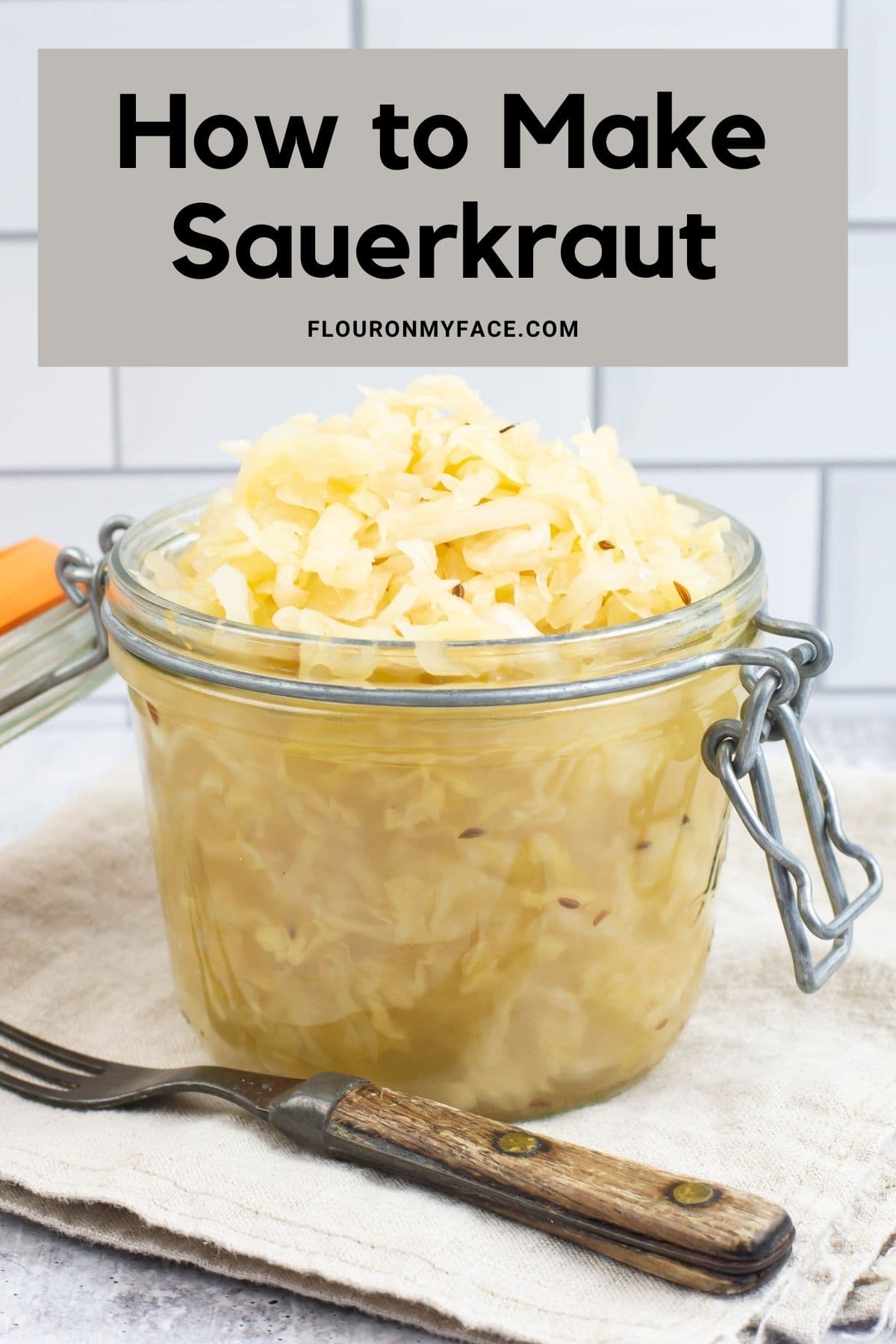
Step 11: After 2 weeks you can open the jar and taste a piece of the sauerkraut. It should be firm and crunchy with a pleasant sauerkraut odor and flavor.
The cabbage will be a paler color and the thinner pieces of cabbage will begin to look translucent.
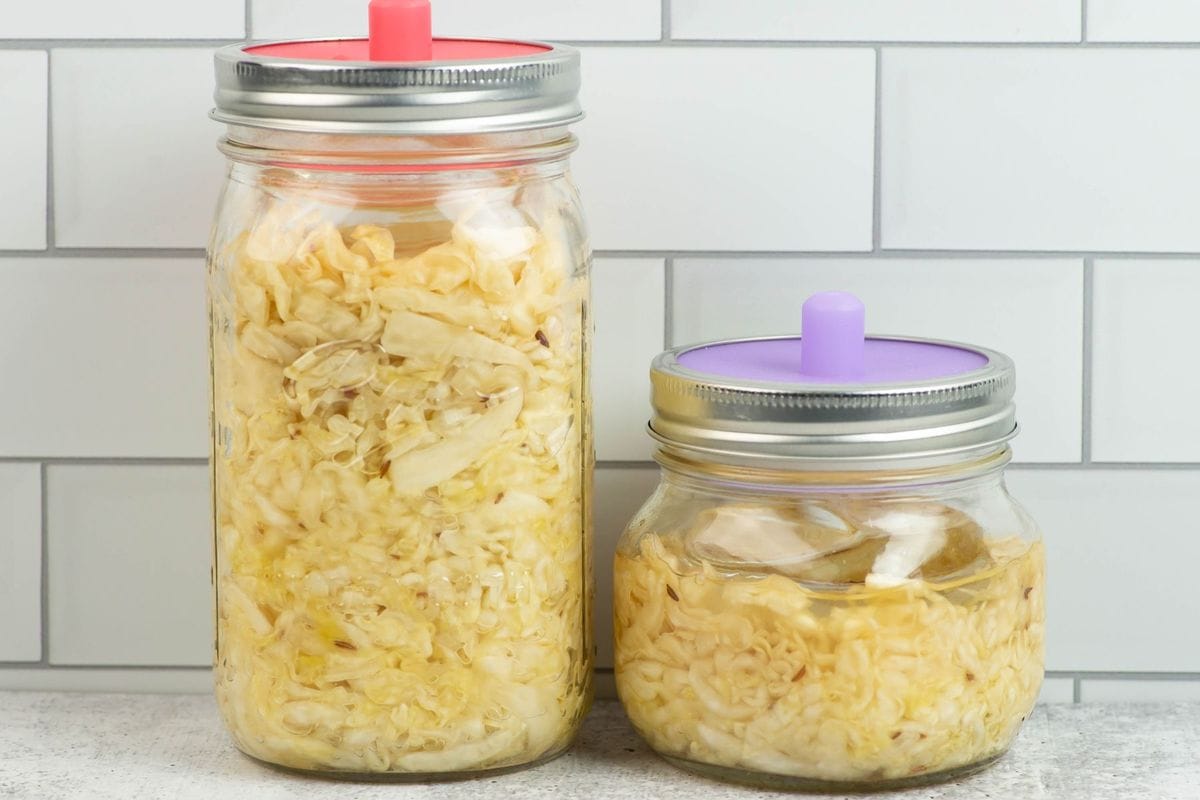
At this point it the sauerkraut has not really developed the full fermented flavor of sauerkraut.
Although some people may like the flavor at this point.
Others may prefer a more robust fermented sauerkraut flavor.
Recover the jar and allow it to ferment one to two more weeks. Occasionally taste a piece to check the flavor.
Storing homemade sauerkraut
Step 12: Once it has reached the perfect flavor you like remove the airlock lid, the fermentation weight and cover the jar with a lid and refrigerate.
You can use the same jars you fermented the cabbage in to store it in the refrigerator. Or you can transfer it to a clean plastic food container before refrigerating.
Congratulations you have made homemade sauerkraut. Enjoy it on a hot dog with whole grain mustard or with some corned beef.
How long will homemade sauerkraut last?
Refrigerated homemade sauerkraut will last many months as long as you are very careful not to introduce bacteria into the jars when you open and remove some.
Always use a clean utensil and never take a bite off of that utensil and put it back into the storage jar.
Recipe FAQS
Fermented foods like sauerkraut are made using a salt brine which creates lactic acid. A lacto ferment is the beneficial bacteria that grow when fermenting sauerkraut and create lactic acid. Lactic acid is not a friendly environment for the bacteria that causes botulism.
It can take 2 to 4 weeks or longer to make fermented sauerkraut. The temperature of your home will determine how long its takes. During the summer when it is warmer the sauerkraut will ferment faster than in the cool or cold winter months. 60 to 70 degrees is the optimum temperature to ferment vegetables.
You will notice small bubbles floating to the top and the brine will get slightly cloudy.
After fermenting you will refrigerate the homemade sauerkraut. Refrigerated sauerkraut will last 6 months or longer as long as it is kept refrigerated properly and no contaminates are introduced to the jar.
Homemade sauerkraut that has gone bad will have a foul odor and be discolored.
Expert Recipe Tips
- Cabbage: After trimming and coring a five pound head of cabbage you are left with about 2 pounds of cabbage. (Yes, I actually weighed the head of cabbage I used for this recipe.)
- Not enough brine to cover the cabbage: Mix ½ teaspoon of pickling salt with ½ cup of warm water. Mix until the salt dissolves. Pour the brine over the cabbage in your jar until all of the cabbage is covered with brine.
- What to use if you don't have any fermentation weights? Cabbage leaves can be tucked in on the top of the cabbage. Or if using a crock you can place a heavy bowl or saucer if it will fit in the container.
- What to use in place of a fermentation airlock lid?: If you do not have a airlock lid you can place a coffee filter over the top of the jar and then screw the canning band over the coffee filter to hold it in place.
- Why is the sauerkraut brine turning cloudy?: Cloudy brine is proof that your cabbage is fermenting. As the natural lactic acid bacteria growth is happening during the fermentation period the brine will turn cloudy. This is proof that fermenting is taking place.
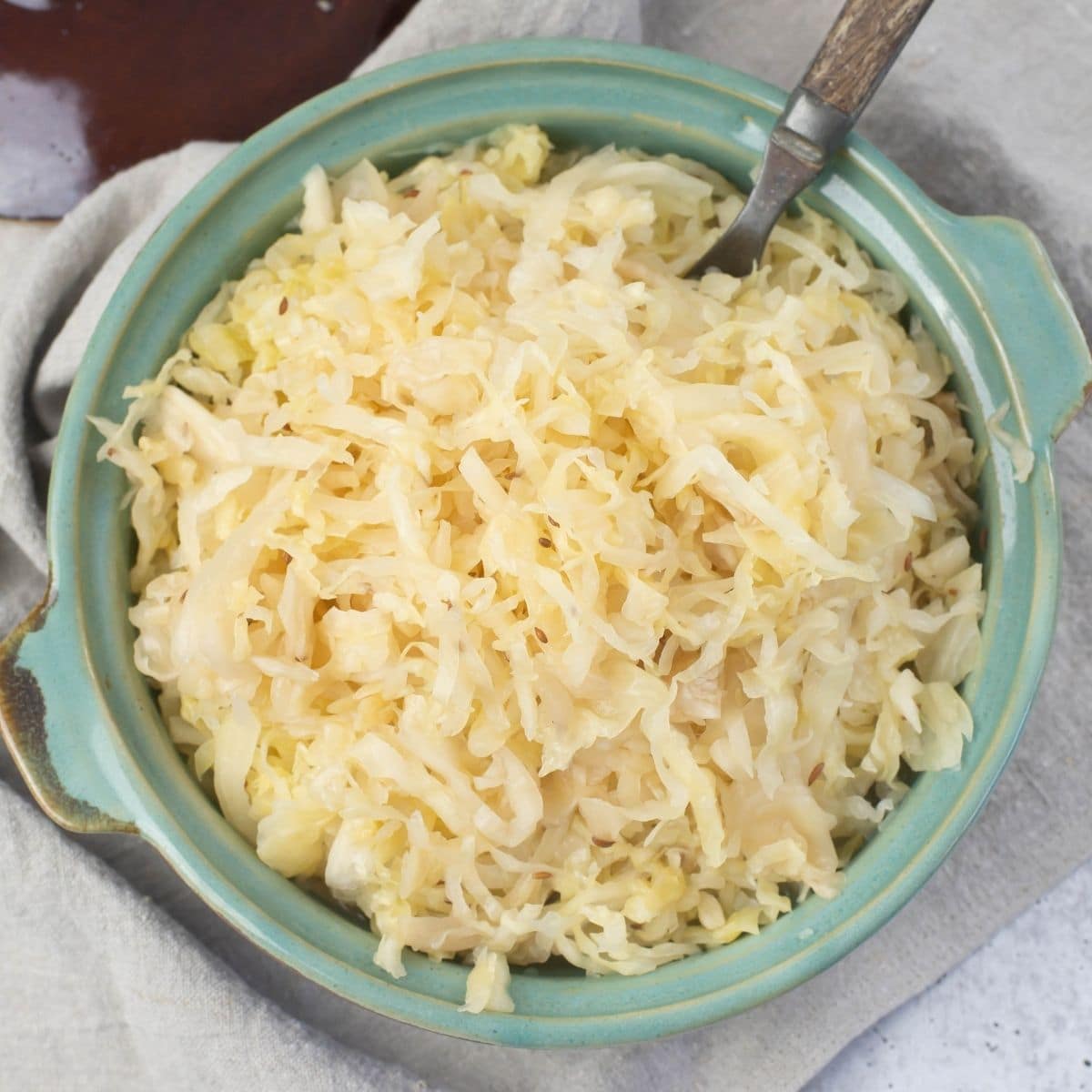
More recipes using fresh cabbage
Here are a few more recipes using fresh cabbage you will love.
Email questions or recipe requests to flouronmyface@gmail.com. Follow me on Pinterest, YouTube, Instagram and Facebook.
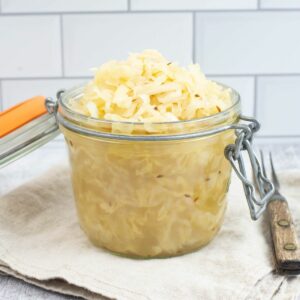
How to make Sauerkraut
Equipment
- 1 Large Bowl
Ingredients
- 1 medium medium head of cabbage
- 1 tablespoon pickling salt
- 1 teaspoon caraway seeds ((optional))
Instructions
- Wash and gently scrub the outside of a head of cabbage. Remove any blemished outer leaves.
- Trim off two to three large outer leaves and set aside. These leaves will be used in place of fermenting weights if you do not have them.
- Cut the head of cabbage in quarters. Trim off the core from each quarter piece. Using a very sharp knife cut the cabbage into very thin shredded ribbons.
- Transfer the shredded cabbage to a large bowl. Add the pickling salt and caraway seed if you are using it.
- Using clean hands toss the cabbage with the salt. As you toss to cover the cabbage with salt squeeze the cabbage to massage the salt in. Do this for about 3 minutes until the salt is evenly distributed.
- If you have a wooden vegetable tamper pound the cabbage until the cabbage is compressed, squeezing out more liquid. If you don't have a vegetable tampering tool you can place a heavy saucer on top of the cabbage and weight it down so it will compress the cabbage and help it release moisture for the brine.
- Place a lint free towel over the top of the bowl and allow the cabbage to release moisture to create the brine. This process can take a couple of hours up to 48 hours.
- Transfer the cabbage and all of the liquid to one or more wide mouth canning jars. Use a wooden sauerkraut pounder to compress the cabbage in the jar. Only fill the jar to the shoulder of the jar to leave space for the weight.
- Place the fermenting weight into the jar if you have one. If you don't you will need to use the whole pieces of cabbage leaves you saved when you trimmed the cabbage earlier.
- Place a silicone fermentation airlock lid on top of the jar. If you don't have one cover the jar with cheesecloth or a coffee filter.
- Screw a canning lid band over the the airlock lid. Place the jar out of direct sunlight on the kitchen counter.
- Place the jar in a safe spot on the kitchen counter that is not in direct sunlight. Allow the sauerkraut to ferment for about 1 month. The airlock system will allow gasses to escape naturally as the cabbage ferments. Check the brine level weekly. (see recipe notes)
- Occasionally, if needed manually release the gasses by squeezing the nob on the silicone top.
- After 2 weeks you can open the jar and taste a piece of the sauerkraut. It should be firm and crunchy with a pleasant sauerkraut odor and flavor.
- Once the sauerkraut has reached the perfect fermented flavor you like remove the airlock lid, the fermentation weight and cover the jar with a lid and refrigerate.
Video
Recipe Expert Tips
- Cabbage: After trimming and coring a five pound head of cabbage you are left with about 2 pounds of cabbage. (Yes, I actually weighed the head of cabbage I used for this recipe.)
- Not enough brine to cover the cabbage: Mix ½ teaspoon of pickling salt with ½ cup of warm water. Mix until the salt dissolves. Pour the brine over the cabbage in your jar until all of the cabbage is covered with brine.
- What to use if you don't have any fermentation weights? Cabbage leaves can be tucked in on the top of the cabbage. Or if using a crock you can place a heavy bowl or saucer if it will fit in the container.
- What to use in place of a fermentation airlock lid?: If you do not have a airlock lid you can place a coffee filter over the top of the jar and then screw the canning band over the coffee filter to hold it in place.
- Why is the sauerkraut brine turning cloudy?: Cloudy brine is proof that your cabbage is fermenting. As the natural lactic acid bacteria growth is happening during the fermentation period the brine will turn cloudy. This is proof that fermenting is taking place.






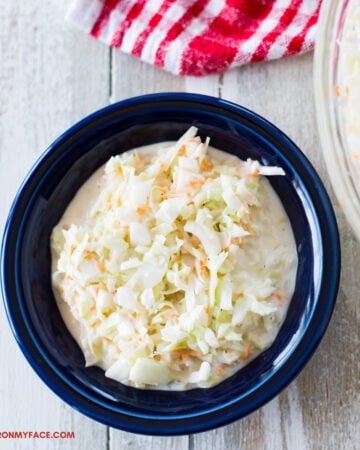


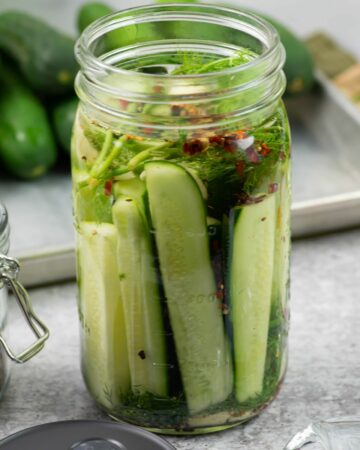
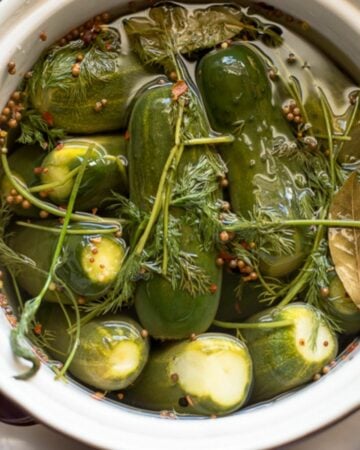

Cindy Rust
That looks yummy! We love cabbage and my hubby especially loves sauerkrat! Thanks for the recipe!